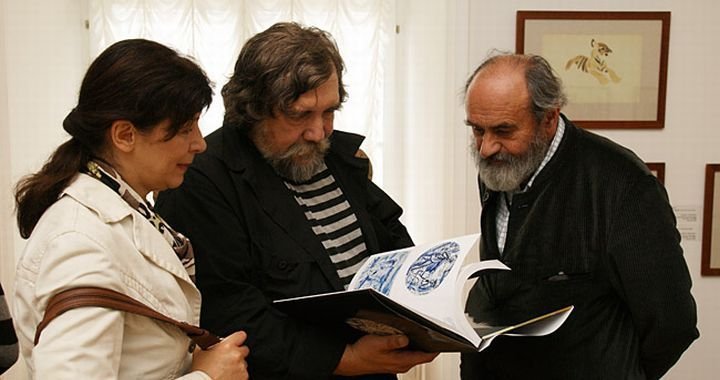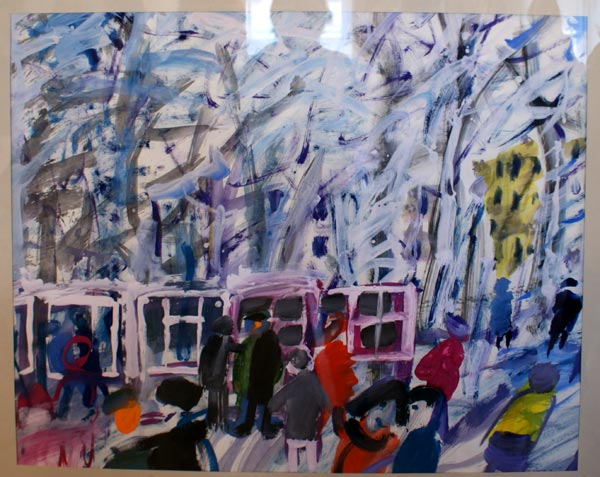
This is for love
The collection of Nikolay Blagodatov
Anna Matveeva
01/02/2013
Another exhibition of Nikolay Blagodatov’s collection at the Anna Akhmatova Literary and Memorial Museum in St. Petersburg has come to an end. And it is a good occasion to think about strategies of art collecting.
I wanted to start by writing that “Nikolay Blagodatov is a unique figure in the community of collectors…”, but this would be a lie. Blagodatov is not only a non-unique figure, but a very typical person for his period of time. The Soviet engineer accidentally got into the underground art community and unwittingly began to collect works of his buddy artists at home. There were quite a few engineers who kept manually typed Solzhenitsyn’s novels and drawings of abstractionists and faggots at the deepest shelf of their wardrobe. But unlike his contemporaries Nikolay Blatodatov managed to step over the borders of his time: he gathered a very powerful and bold collection, which in the perspective turned out to be very important. But times have changed and the new formation of collectors, who were only interested in sales and ratings, have now got a chance to meet the other strategy of collecting. This strategy of collecting with the soul component has, of course, occurred as a result of an era when everything was done just for pleasure as there were no other stimuli. This way of collecting, however, didn’t move on, come new times, and there are reasons for it. But selfless collecting of the late-Soviet period not only hasn’t vanished, it has also shown the results that now deserve a museum representation. It presents all the main names of 1970s and 1980s: Richard Vasmi, Vladimir Shagin, Vadim Ovchinnikov and many others. And these collections feel great and keep on accumulating new items.

Photo: Nikolay Semenovsky
How long have you collected art and how many items are in your collection?
I started collecting in the end of 1975. Right now, I have more than 3000 items, not only paintings but also graphic art and small sculptures that can be kept in my apartment, but for most part they are sheets in the maps.
I have caught this virus of contemporary art, Russian contemporary art, especially one of Leningrad. This happened after the exhibitions of nonconformist artists in 1974 and 1975 at Ivan Gaza Culture Centre and Nevsky Culture Centre in Leningrad. When I was shaping as a personality, the thaw had just begun: Impressionists were brought to the public, also Fauvists, our Silver Age and a bit of Avant-garde. With Soviet realist art at the background, all this new art seemed very fresh, interesting and new, even though it was a few decades old. One also should consider the spirit of nonconformism in those who were interested in contemporary art: if something is banned, then it must be good. My generation and I got lost at the third floor of Hermitage Museum. Then two national exhibitions took place in Moscow: American in 1958 and French in 1961. There was everything, including art. I went there for that purpose as I was really interested.

Work of Vladimir Shagin from the collection of Nikolay Blagodatov
This is what I was like when in 1974 a remarkable exhibition of nonconformists at Ivan Gaza Culture Centre was opened: I went there, stood in line for six hours to get in, and came back repeatedly. I was totally shaken by the atmosphere of free speech, of human independence. It was a breath of fresh air in the rigid system. By the way, not all underground artists were exhibited at those two shows. There were about 40 authors at the first exhibition and about 80 at the second one. It was a selection from a huge block of culture. In one word, by 1975 I was completely in love with these artists and started to hang out with them.
At one point I was offered to purchase something. I talked to my wife about it and we bought several sheets of graphic art. Then a few more works and a few more... Then I began to get invited to home exhibitions and I was buying small graphic works of art.
A simple engineer could afford to purchase art?
An engineer of my level made about 120 roubles per month. One sheet of graphic art was about 25 roubles. So, it wasn’t cheap, but if you considered things well, you could afford it.

Work of Valery Mishin from the collection of Nikolay Blagodatov
Then people started to leave the country. Huge success of these underground exhibitions scared the government, and such grand shows were not allowed anymore, just the smaller ones: solo or few people exhibitions at some culture houses at the outskirts. There were no more queues for them. Many artists left the country. However, when they tried to take their works with them, the government decided that artists should pay for the exportation of art. There is the paradox: you are nobody and your work is rubbish, but when you’re trying to leave, this rubbish turns out to be art and you have to purchase it from yourself! Many decided to take money with them rather than paintings. Sales went off, and I bought many pieces of art back then. Many artists presented their pieces to me: for instance, Shapiro brought a map of graphic art to leave at my place because he didn’t know where to put it. My collection grew rapidly back then. I had almost a home museum, my popularity grew too, and many artists were willing to sell and present their works to me.
Then times became more liberal, exhibitions opened, and I was asked to say some words at the vernissages. My popularity grew and added a certain prestige to my collection, which again meant more presents. It still continues to this way. Even with contemporary artists who sell their works for big money, some of them say: I remember, you said good words about this picture; I want to give it a present for you.

Vladimir Yashke. Head of a Girl. Mixed technique
Blagodatov didn’t shape his collection. Sometimes he purchased something he liked, but mostly he took charge of the things, which the artists have given him as a present or when leaving as they had no other place to leave their belongings. This absence of personal collector’s choice is not a disadvantage, but rather a privilege: today the general value of this collection is mostly historical. It is the reflection of its time, one could write a history book on an unofficial culture of Leningrad in the last quarter of 20th century by observing this collection.

Work of Alexander Rumyantsev from the collection of Nikolay Blagodatov
Have you ever received an offer to sell your collection?
Yes, I have, several times, but I always refuse. I am not an entrepreneur. Besides, many of these works are presents or have been purchased for cheaper price than an outsider would have paid for them. That’s why I don’t accept offers to sell certain works to other collectors. I have, however, donated several works to the museums.
How do you exhibit your collection?
Works from my collection are quite often included in exhibitions. I have given works of Oleg Grigoryev to his memorial exhibition, also Aleksandr Manusov’s work. I have also had more than 50 exhibitions of my collection. In this sense, I am one of the most actively exhibiting collectors in Russia. But I can’t exhibit all I have at once. I mostly stand by the principles one work per artist because I want to show as many authors as I can.
The next exhibition I am planning to do, I guess will take place in the Smolny Cathedral in St. Petersburg. Although, I was given a warning that this is still a cathedral, so contemporary art can raise some disagreement: There are some mean wives working there... but I realize that we should avoid displaying acts or some drunkard pictures. If we look at The Cathedral drawn by Solomon Rossin: it is deeply Christian painting, but can you imagine his style! Or his Metropolitan Nikodim’s Funeral, it’s an amazing painting. I wanted to purchase it so much, so I set the price with Rossin and came after it with money. And Rossin tells me: You know, I’ve decided that I can’t sell it to you. Oh, I was so surprised. And then he said he wanted to present it to me. In the opinion of Rossin this painting has already been paid for. He received a visit from an Orthodox priest, who looked at the picture, then took off his cross and presented it to the artist. Solomon Rossin thought it was enough. So, one could say this painting is twice Christian. But is it okay to exhibit it at the Smolny Cathedral? I am still thinking about it... well, of course, we’ll choose something.
Private collections that are shaping randomly, in the result of close friendships with artists, rather than on the will and money of the collector, have always existed and still exist. The collection of Nikolay Blagodatov is just the top of the iceberg. It is the fullest and most exhibited collection of Leningrad’s unofficial late-Soviet art. The way of collecting also is everything but unique: firstly, the vague general interest, then the entering in the society, the interaction with its members as a riveting cultural trip, and then having works appear in the collection. Basically, we can differ two approaches towards collecting art: one when a collector, sometimes in association with a hired expert, marks some top names and consequently purchases them; and the other one when a collector lives in the artistic environment and cultural layer of his collection grows in a natural way. The first approach is more beneficial in the short term (and also looks more glamorous), but the other one is more beneficial in the long term. But usually the collectors of the second category, like Nikolay Blagodatov, are often emotionally merged with their environment so that the matter of a benefit is completely out of the question.